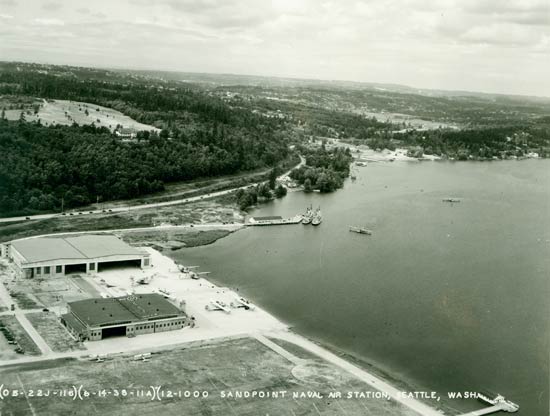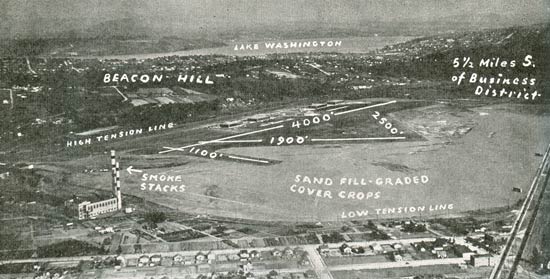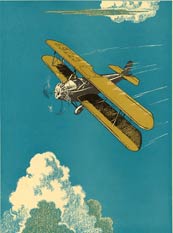|
Seattle, WA during the Golden Age was the site of both military and civil aviation activities. Sixteen pilots landing at Tucson identified their home base as Seattle. Two pilots cited Seattle as the point from which they arrived at Tucson, and four pilots, including three military aviators, identified Seattle as their destination.
One military destination in the Seattle area was the Sand Point Naval Air Station. Below, a high-quality photograph of Sand Point taken June 14, 1938, soon after the Register of the Davis-Monthan Airfield was closed. Image donor (right sidebar), Mr. Kalina , states about this image, "As you can see, it is an official military photo [identified by the coding along the bottom].... Of note is the Boeing 314 prototype in the upper center of the photo [hard to see in this Web image, but it's just to the right of the clump of trees at center, just at water's edge]. Note that it has the original, single tail [vertical stabilizer]. This was soon changed to ... the production version of 3 tails. The amphibians are PBYs [eight are visible in the water and on land]. Note that the ones on shore appear to have different paint schemes on their fin/rudders. The two closest appear to have a checkerboard pattern."
These details are barely visible in the Web copy of this image, but they are very clear in the original. From the wake, the PBY to the right of the two ships at dock is underway. Note the launch or recovery crew standing at the end of the ramp and in the water just above the two PBYs facing north. They may be waiting to recover the incoming aircraft near the two ships, or they may be preparing to launch the one just visible at the top right corner of the dark roofed hangar.
Sand Point Naval Air Station, June 14, 1938, 11:00AM
 |
The painting on the dark hangar roof in the foreground says "NAS SEATTLE". North is to the right of the image. One Register pilot cited Sand Point specifically as his home base. He was lieutenant Theodore J. Koenig. Koenig flew 24-131, a deHavilland DH-4MB1. He carried passenger L.G. Hubble. They were westbound from Biggs Field, El Paso, TX to Los Angeles, CA. Koenig noted in the remarks column of the Register, "Then to Seattle, Wash". Other military pilots (Army Air Corps) to cite Seattle were Ira Eaker and Oakley Kelly. See the link in the left sidebar for further information about Sand Point.
Civil pilots of the Register probably were headed for Seattle's Boeing Field. Among civil pilots whose home base was Seattle were Erik Nelson (landed five times; he worked for Boeing), and George Westinghouse (three times; he lived in Seattle). Below, Boeing Field circa 1933 from this REFERENCE, page 236.
Boeing Field, Seattle, WA, Circa 1933
 |
Boeing Field facing ENE in 1933 was located within the city limits of Seattle, 5.5 miles south of the business district, which would be to the left of the image. At the time it was 458 acres, with the northeast 70 acres covered in cinders (the dark area where the runway measurements are sketched).
The main obstructions, smoke stacks and a high tension line, are labeled on the image. The airfield had a revolving beacon, boundary lights, flood lights, obstruction lights and an illuminated wind tee. There was a telephone on the field: number Glendale 0747.
There were two radio stations on the field, Aeronautical Radio, Inc. radio station KZJ operating at 278 Kc, and Department of Commerce radio station KCZ operating at 344 Kc. Weather reports were available on the field, as were a restaurant. Hotels and other restaurants were available in the city for a cab fare of $1.00.
Fuel, oil and aircraft storage services were available, as were licensed mechanics night and day. Interestingly, storage rates were computed based on wing span: 5-cents per foot per day; $1.00 per foot per month.
The Boeing Aircraft Company, Coast Air Lines, Mamer Air Transport, North Coast Air Service, Northwest Air Service, Safeway Air Service, United Air Lines and Western Airways did business at Boeing Field during the period of the Register. The 489th Bombardment Squadron, Air Reserve, was based at Boeing Field.
Below, a 1933 advertisement for Northwest Air Service, which provided airframe (the "A" in the last line of the ad) and engine (the "E") supplies and maintenance. At least one Register airplane, Lockheed Vega NC162W was repaired at Northwest Air Service. They offered Berry Brothers coating products.
Northwest Air Service Advertisement, Circa 1933
 |
The contemporary Boeing Field is pictured below. It is now known as King County International Airport. This view, from Google Earth, is adjusted to about the same viewpoint as the one above. The single, main runway runs left to right. Note Lake Washington in the background, along with Mercer Island, visible in both images.
Boeing Field, 2008
 |
Boeing Field is now used mostly for general aviation and cargo operations. Passenger operations are carried on mostly at the Seattle-Tacoma International Airport. The Seattle Museum of Flight is adjacent to the south end of the runway.
---o0o---
UPLOADED: 11/17/08 REVISED: 02/26/09
|





